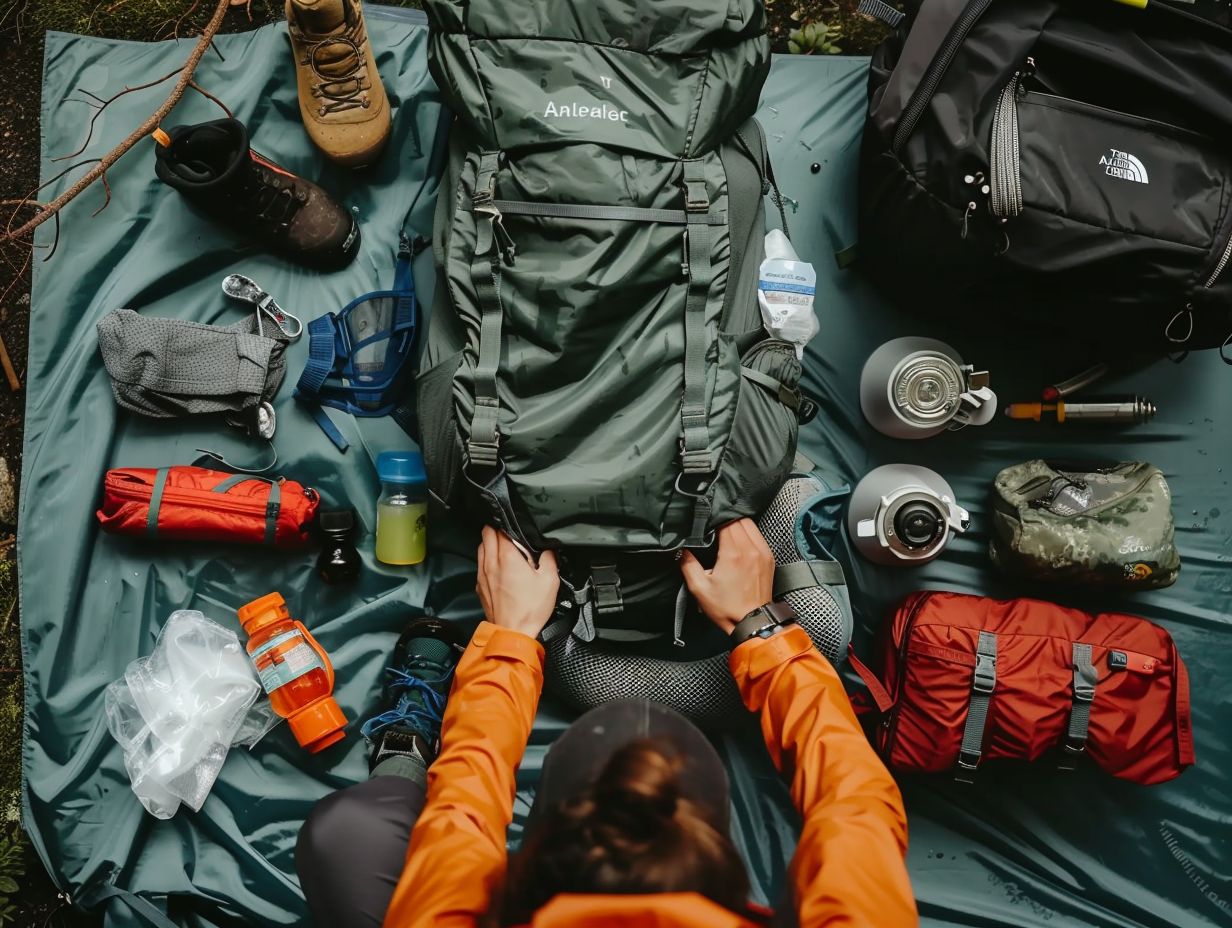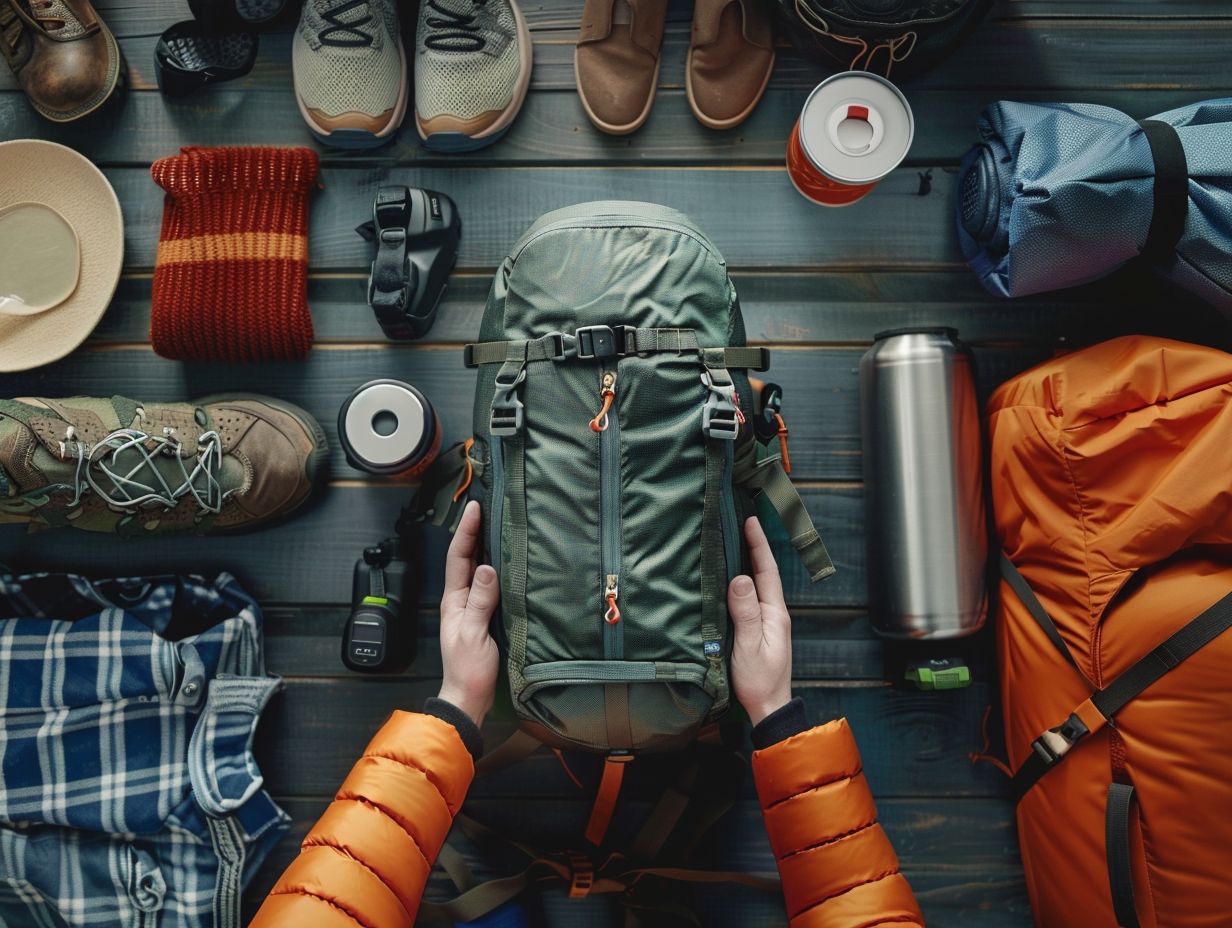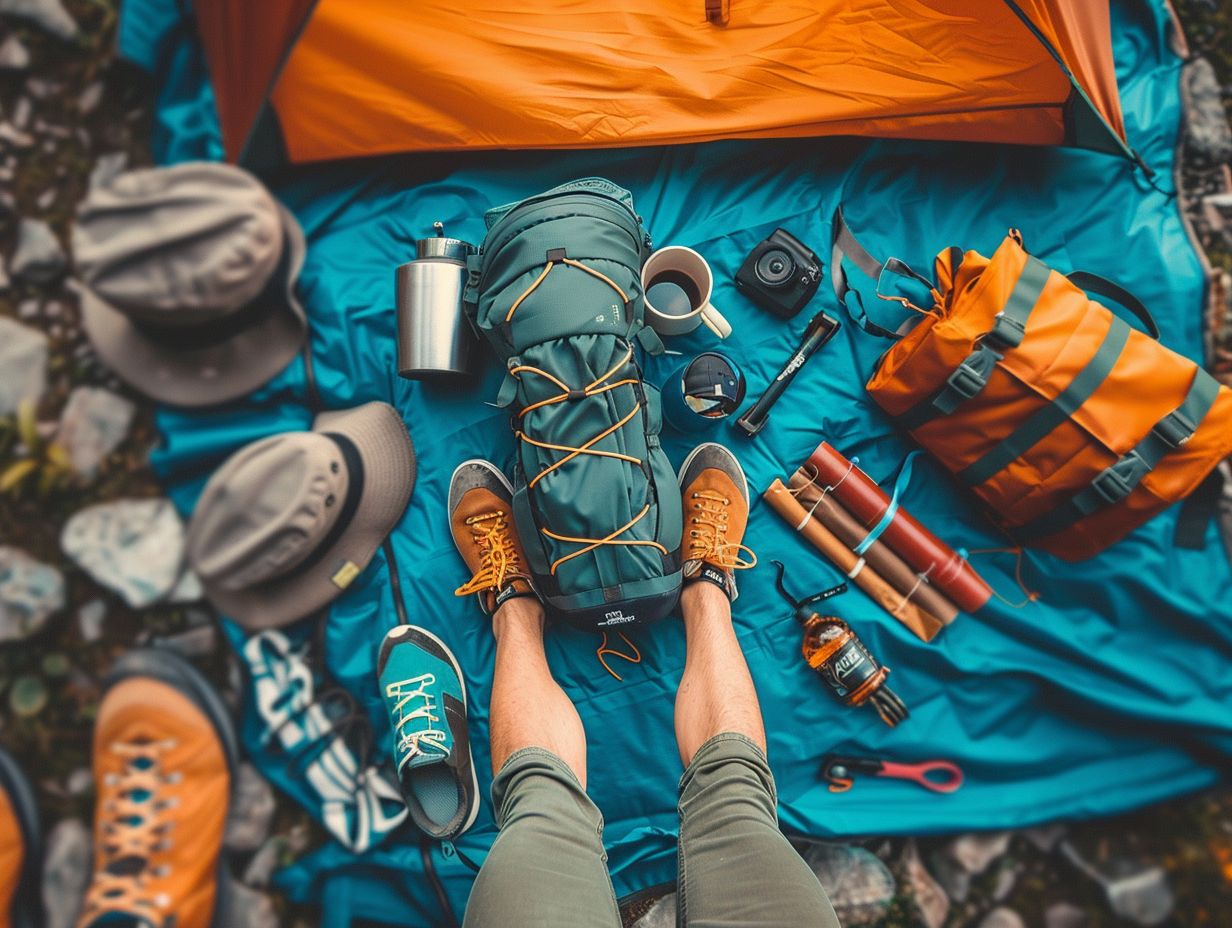If you are considering embarking on your first backpacking adventure but feeling uncertain about where to begin, this comprehensive guide covers essential gear, must-have items, planning your route, physical preparation, food and water strategies, setting up camp, staying safe in the wilderness, and environmental responsibility.
Ensure you are well-prepared for an unforgettable outdoor experience by grabbing your gear and getting ready to explore the great outdoors!
Key Takeaways:

- Make sure to pack essential gear like a reliable backpack, proper clothing, and navigation tools for a successful backpacking trip.
- Plan your route and itinerary carefully, taking into account factors such as distance, terrain, and weather. Research and map out your trip to ensure a smooth and safe journey.
- Physical preparation is crucial for a successful backpacking trip. Train and condition your body for the physical demands of the trail to avoid injury and discomfort.
What is Backpacking?
Rucksacking is a form of travel where you immerse yourself in nature, typically carrying essential kit and supplies on your back to explore remote and wilderness areas. This journey often involves hiking through rugged terrains, camping under starry skies, and appreciating the beauty of untouched landscapes.
The essence of rucksacking lies in your self-sufficiency as a traveller, relying on your skills and resourcefulness to navigate through natural surroundings. This type of trip allows you to disconnect from the hustle and bustle of urban life, offering a chance to reconnect with the simplicity of the wilderness.
The thrill of venturing into the unknown and the tranquillity of being surrounded by nature create a unique experience that is both challenging and rewarding.
Essential Gear for Backpacking
To embark on a successful backpacking adventure, it is essential that you possess the appropriate kit. Key items to include in your kit list are:
- a reliable rucksack,
- a suitable camping shelter,
- a water filtration system,
- appropriate clothing, and
- any other necessary equipment.
Must-Have Items for a Successful Trip
When preparing for a backpacking trip, there are several critical items that are essential for a successful journey. These items include:
- a sturdy rucksack,
- camping equipment,
- a sufficient water supply,
- appropriate clothing for varying weather conditions, and
- essential navigation tools.
A sturdy rucksack is crucial for carrying all of your essentials and needs to be comfortable to endure long treks. Camping equipment such as a tent, sleeping bag, and cooking equipment ensures that you have a comfortable night’s rest and access to nourishing meals.
It is vital to have a sufficient water supply to remain hydrated during your hike, particularly in remote locations. Appropriate clothing is necessary to protect you from elements like rain and cold, while navigation tools such as a map and compass are essential to prevent you from getting lost in unfamiliar terrains.
Planning Your Route and Itinerary
Efficient planning of your backpacking route and itinerary is crucial to ensure a safe and enjoyable adventure. This process involves identifying the trail, calculating the required time, and honing your navigation skills.
Factors to Consider and Tips for Mapping Your Trip

When mapping out your backpacking trip, you must consider factors such as terrain difficulty, available time, navigation skills, and map selection to ensure a successful journey. It is crucial to choose maps wisely to facilitate a smooth and safe adventure.
A thorough understanding of the terrain you will encounter is vital for planning a successful backpacking trip. Take into account topographical features, elevation changes, water sources, and potential hazards along your route.
Evaluating time constraints is also essential, as they will determine the feasibility of your itinerary. Proficiency in navigation techniques, such as compass reading, GPS device usage, and topographic map interpretation, is invaluable when exploring unfamiliar areas.
Selecting the appropriate type of map for the region you plan to explore is paramount. Whether you opt for a detailed topographic map or a simplified trail map, choosing the right map will greatly assist you in navigation and ensuring a successful backpacking experience.
Physical Preparation for Backpacking
Ensuring physical preparation is crucial for backpacking, especially for beginners like yourself. It is important to focus on building fitness levels, acquiring fundamental backpacking skills, and honing mental preparedness to guarantee a successful and enjoyable trek.
Training and Conditioning for the Trail
Training and conditioning are crucial aspects of preparing for a backpacking adventure. Acquiring experience, improving fitness levels, and honing essential skills will enhance your backcountry experience.
Having the right physical fitness and skill set can significantly impact your overall enjoyment and success during backpacking trips. Regular training not only strengthens your body but also increases endurance and resilience, enabling you to tackle challenging terrains with greater confidence.
Conditioning exercises can focus on key muscle groups utilised in backpacking, such as legs, core, and back, reducing the likelihood of injuries and fatigue. Practising essential outdoor skills like map reading, navigation, and campsite setup through training sessions can improve your proficiency and readiness for various scenarios in the wilderness.
Food and Water for Backpacking
Ensuring proper nutrition and hydration is essential for backpacking. Planning nutritious meals, carrying enough water, and implementing effective hydration strategies are crucial for maintaining energy levels while on the trail.
Meal Planning and Hydration Strategies
When preparing for a backpacking trip, it is essential to create a comprehensive meal plan and implement effective hydration strategies to maintain your energy and stamina. You should prioritize lightweight, nutritious food options and ensure you are consuming an adequate amount of water.
A helpful tip is to consider opting for dehydrated meals or lightweight snacks such as nuts, dried fruits, and energy bars. These food choices provide essential nutrients without significantly increasing the weight of your pack.
When planning your meals, focus on selecting foods that are high in calories and protein to efficiently fuel your body during the trip. Utilising a water filtration system or water purification tablets can assist you in staying hydrated without carrying excessive weight from water.
It is crucial to consume small sips of water regularly throughout the day to prevent dehydration and maintain optimal performance.
Setting Up Camp and Staying Safe

When backpacking, it is essential for you to establish a secure campsite and prioritise safety measures. Knowing how to set up shelter properly, remaining vigilant at night, and adhering to safety protocols are key components in ensuring a peaceful and secure wilderness experience.
Tips for Setting Up Camp and Staying Safe in the Wilderness
When you are setting up camp in the wilderness, it is crucial to prioritize safety. Begin by selecting a suitable location that is flat, dry, and free from potential hazards like loose rocks or dead trees. Make sure to inspect the surrounding trees for any dead branches that could pose a risk during high winds.
Your shelter should be stable and securely anchored, utilising appropriate tie-downs and stakes. It is important to follow Leave No Trace principles while camping. Properly store all food to avoid attracting wildlife and maintain a safe distance from wild animals, refraining from feeding or approaching them.
Additionally, always have a first aid kit on hand and be knowledgeable about emergency procedures in case of injuries or unfavorable weather conditions. Stay vigilant throughout the night and be prepared for any unforeseen circumstances that may arise during your camping trip.
Leave No Trace Principles
Adhering to Leave No Trace principles is essential for promoting environmental responsibility during your backpacking expeditions. These guidelines are designed to reduce human impact on natural ecosystems and maintain the integrity and beauty of wilderness areas.
Environmental Responsibility and Best Practices for Backpacking
Practising environmental responsibility through adherence to Leave No Trace principles is one of the best ways for you to minimise ecological impact while enjoying the beauty of natural landscapes during your backpacking trips. By following these principles, you can significantly reduce your footprint on the environment.
Leave No Trace emphasises simple yet crucial practices such as:
- Packing out all rubbish
- Staying on designated paths to avoid disrupting natural habitats
- Minimising campfire impact
- Respecting wildlife by observing from a distance
These actions not only help preserve the delicate ecosystems of wilderness areas but also ensure that future generations can continue to revel in the splendour of outdoor adventures without causing harm to the environment.
Frequently Asked Questions
What should I consider when choosing a backpack for my first backpacking trip?

When choosing a backpack, consider the length of your trip, the terrain you will be hiking on, and the amount of gear you will need to bring. Look for a backpack that is comfortable, durable, and has multiple compartments for organization.
What type of clothing should I pack for my first backpacking trip?
When packing clothing for a backpacking trip, choose items that are lightweight, quick-drying, and versatile. Pack layers that can be easily added or removed depending on the weather. Avoid cotton materials as they retain moisture and take a long time to dry.
How much food and water should I bring for my first backpacking trip?
The amount of food and water you should bring will depend on the length of your trip and your personal needs. As a general rule, plan for 2-3 litres of water per day and bring lightweight, non-perishable foods that are high in energy and nutrition.
What essential gear should I pack for my first backpacking trip?
Some essential gear you should pack for a backpacking trip includes a tent, sleeping bag, sleeping pad, backpacking stove, appropriate footwear, navigation tools, first aid kit, and a headlamp. Make sure to research and pack gear that is suitable for your specific trip.
How can I prepare physically for my first backpacking trip?
In order to prepare physically for a backpacking trip, incorporate regular cardio and strength training exercises into your fitness routine. It is also important to gradually increase the weight of your backpack on training hikes to build endurance and strengthen your muscles.
What safety precautions should I take before embarking on my first backpacking trip?
Before embarking on a backpacking trip, make sure to familiarise yourself with the area, check weather conditions, and inform someone of your itinerary. Pack a first aid kit, know basic navigation skills, and be aware of any potential hazards such as wildlife or weather changes. Always follow Leave No Trace principles to minimise your impact on the environment.



